Health Advancement and Promotion: Strategies for Diabetes Management
VerifiedAdded on 2019/10/31
|13
|2552
|308
Report
AI Summary
This report provides a comprehensive literature review on health advancement and promotion, with a specific focus on type 2 diabetes management within the Australian context. It explores the importance of health promotion in enhancing fitness and reducing disease rates, highlighting the limitations of education alone and advocating for a more comprehensive approach. The report employs the 4Es model—Education and Information, Enforcement, Policy and Guidelines, Environment and Engineering—to analyze health promotion strategies. A systematic review of relevant literature, including databases such as MEDLINE, CINNAHL, EMBASE, and the COCHRANE library, is conducted, with inclusion and exclusion criteria applied to narrow the search. The evidence supports the implementation of diabetes management programs, particularly type 2 diabetes, which is prevalent in Australia. The report presents a checklist for systematic review, outlines the 4Es model, and concludes with a call for proactive environments that provide care and acknowledgment for individuals with diabetes, emphasizing the potential of technological interventions such as web-based learning and mobile health services. Study objectives are framed to control the adverse health impacts of type 2 diabetes through self-management techniques and to spread literacy regarding the development and prognosis of the disease.
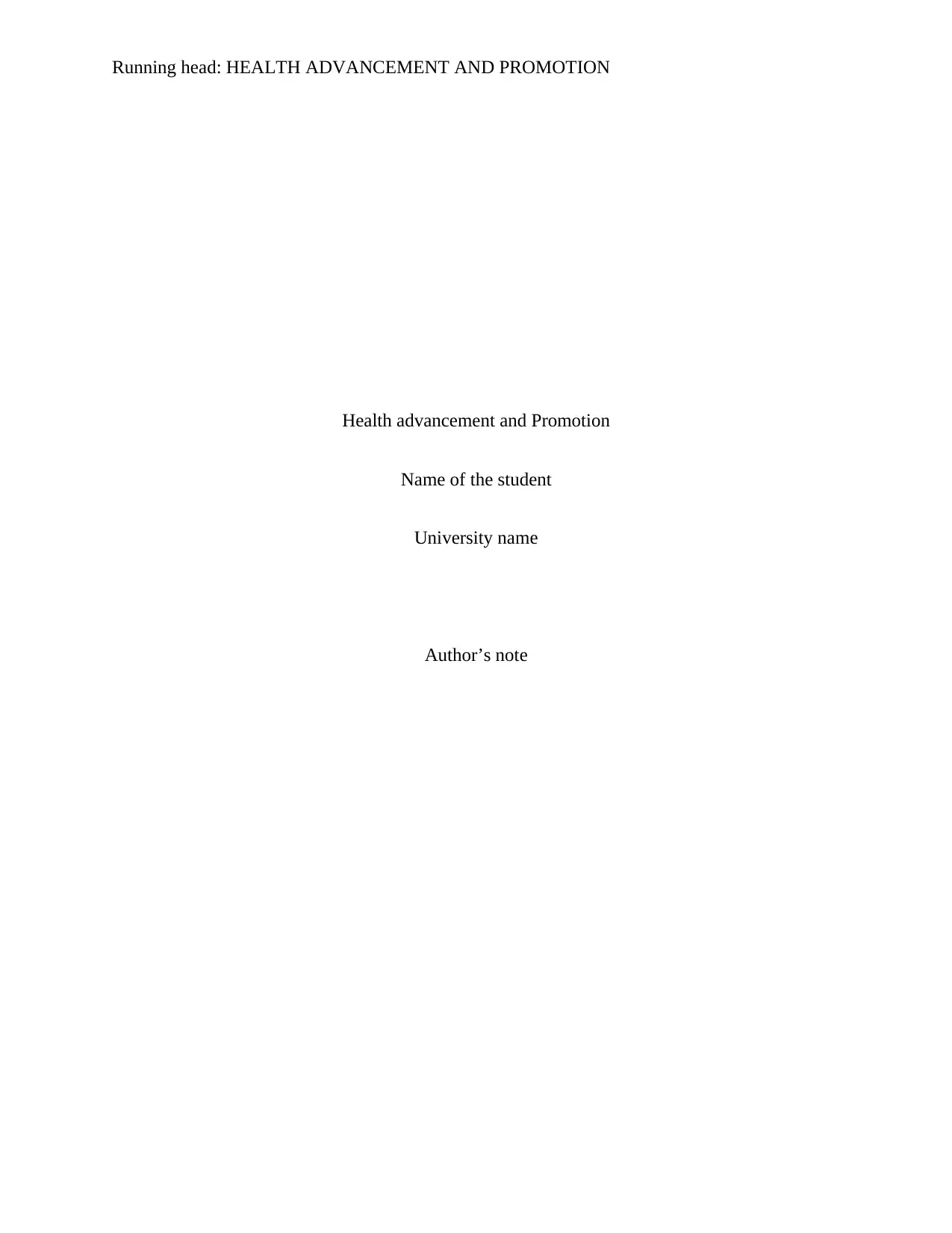
Running head: HEALTH ADVANCEMENT AND PROMOTION
Health advancement and Promotion
Name of the student
University name
Author’s note
Health advancement and Promotion
Name of the student
University name
Author’s note
Paraphrase This Document
Need a fresh take? Get an instant paraphrase of this document with our AI Paraphraser
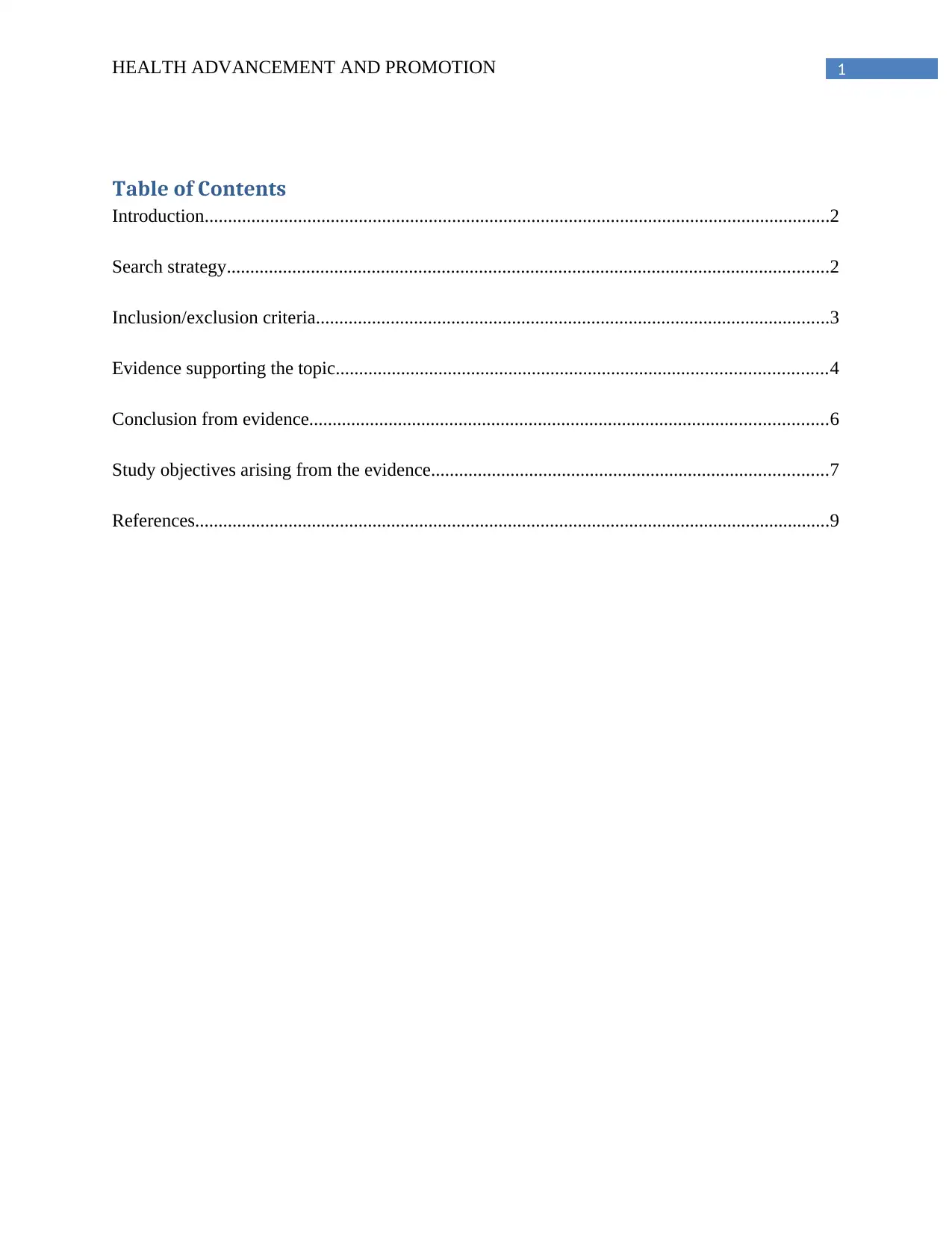
1HEALTH ADVANCEMENT AND PROMOTION
Table of Contents
Introduction......................................................................................................................................2
Search strategy.................................................................................................................................2
Inclusion/exclusion criteria..............................................................................................................3
Evidence supporting the topic.........................................................................................................4
Conclusion from evidence...............................................................................................................6
Study objectives arising from the evidence.....................................................................................7
References........................................................................................................................................9
Table of Contents
Introduction......................................................................................................................................2
Search strategy.................................................................................................................................2
Inclusion/exclusion criteria..............................................................................................................3
Evidence supporting the topic.........................................................................................................4
Conclusion from evidence...............................................................................................................6
Study objectives arising from the evidence.....................................................................................7
References........................................................................................................................................9
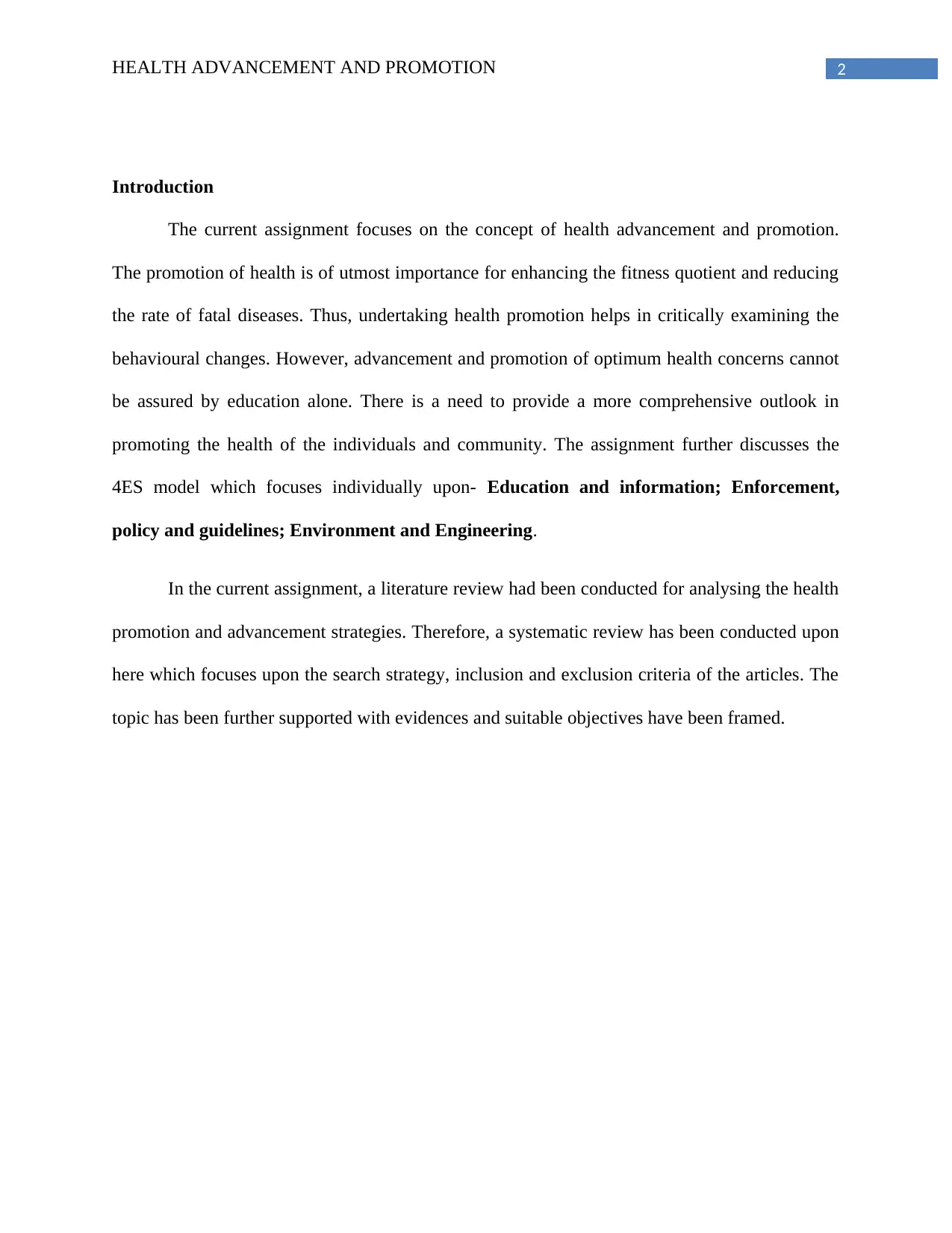
2HEALTH ADVANCEMENT AND PROMOTION
Introduction
The current assignment focuses on the concept of health advancement and promotion.
The promotion of health is of utmost importance for enhancing the fitness quotient and reducing
the rate of fatal diseases. Thus, undertaking health promotion helps in critically examining the
behavioural changes. However, advancement and promotion of optimum health concerns cannot
be assured by education alone. There is a need to provide a more comprehensive outlook in
promoting the health of the individuals and community. The assignment further discusses the
4ES model which focuses individually upon- Education and information; Enforcement,
policy and guidelines; Environment and Engineering.
In the current assignment, a literature review had been conducted for analysing the health
promotion and advancement strategies. Therefore, a systematic review has been conducted upon
here which focuses upon the search strategy, inclusion and exclusion criteria of the articles. The
topic has been further supported with evidences and suitable objectives have been framed.
Introduction
The current assignment focuses on the concept of health advancement and promotion.
The promotion of health is of utmost importance for enhancing the fitness quotient and reducing
the rate of fatal diseases. Thus, undertaking health promotion helps in critically examining the
behavioural changes. However, advancement and promotion of optimum health concerns cannot
be assured by education alone. There is a need to provide a more comprehensive outlook in
promoting the health of the individuals and community. The assignment further discusses the
4ES model which focuses individually upon- Education and information; Enforcement,
policy and guidelines; Environment and Engineering.
In the current assignment, a literature review had been conducted for analysing the health
promotion and advancement strategies. Therefore, a systematic review has been conducted upon
here which focuses upon the search strategy, inclusion and exclusion criteria of the articles. The
topic has been further supported with evidences and suitable objectives have been framed.
⊘ This is a preview!⊘
Do you want full access?
Subscribe today to unlock all pages.

Trusted by 1+ million students worldwide
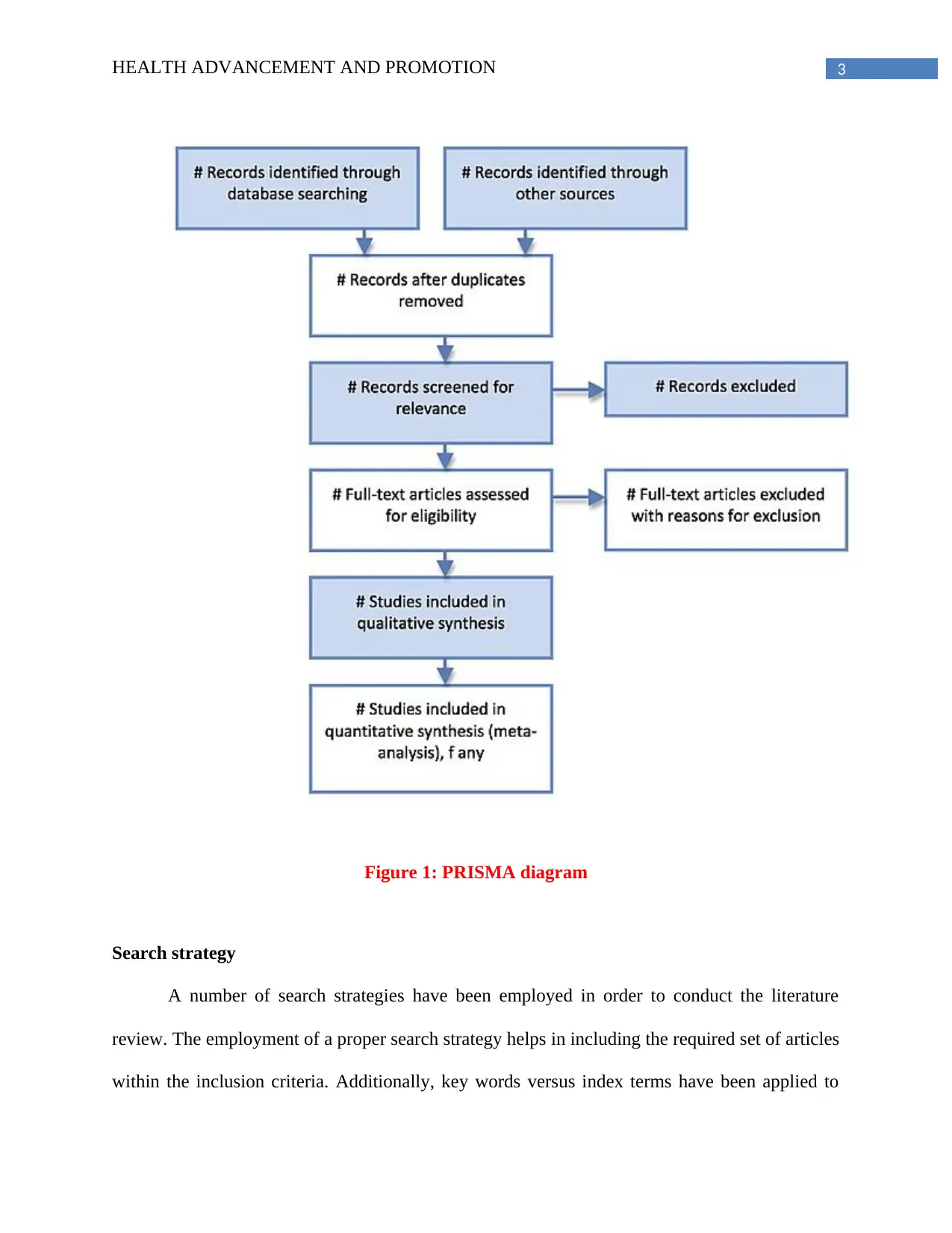
3HEALTH ADVANCEMENT AND PROMOTION
Figure 1: PRISMA diagram
Search strategy
A number of search strategies have been employed in order to conduct the literature
review. The employment of a proper search strategy helps in including the required set of articles
within the inclusion criteria. Additionally, key words versus index terms have been applied to
Figure 1: PRISMA diagram
Search strategy
A number of search strategies have been employed in order to conduct the literature
review. The employment of a proper search strategy helps in including the required set of articles
within the inclusion criteria. Additionally, key words versus index terms have been applied to
Paraphrase This Document
Need a fresh take? Get an instant paraphrase of this document with our AI Paraphraser
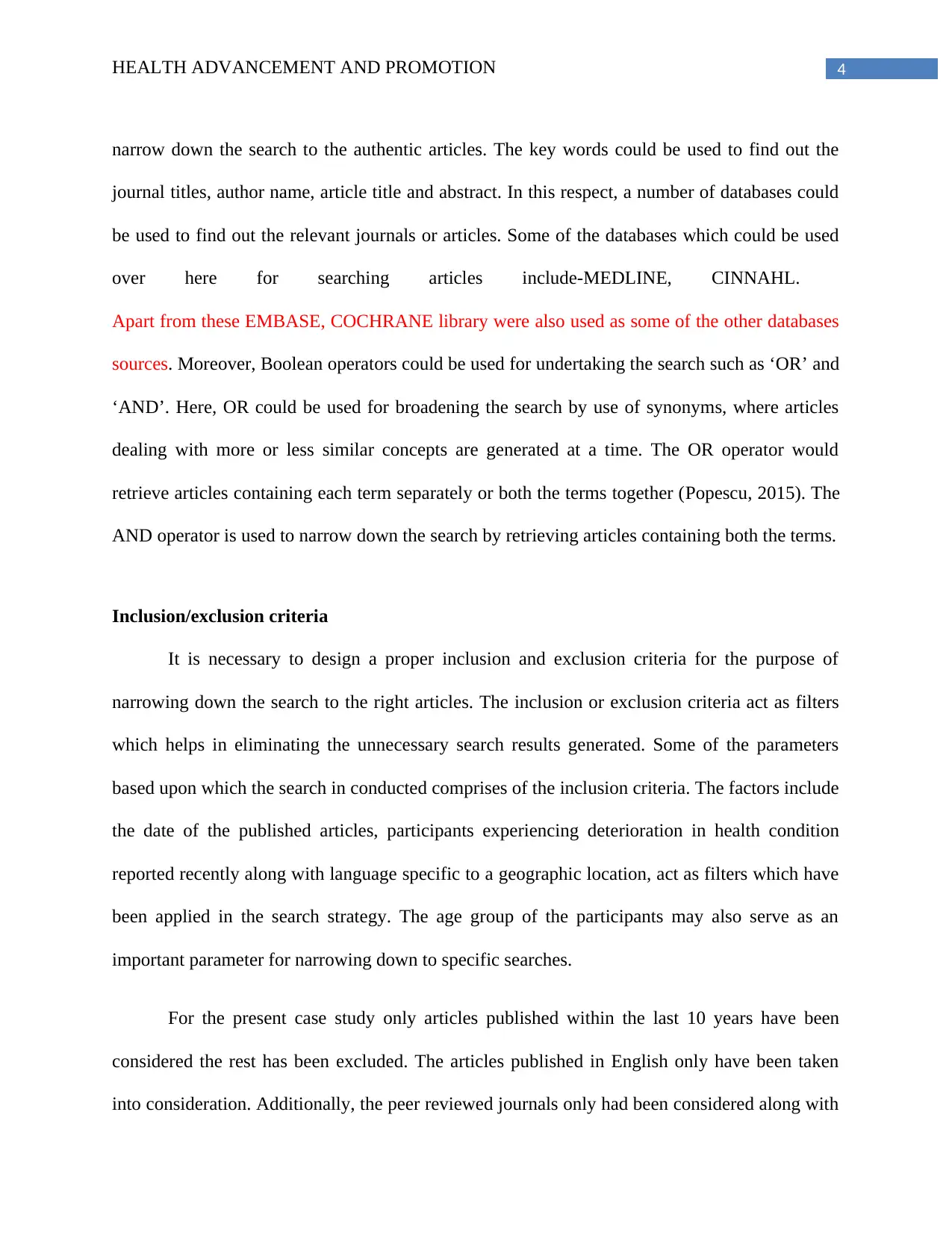
4HEALTH ADVANCEMENT AND PROMOTION
narrow down the search to the authentic articles. The key words could be used to find out the
journal titles, author name, article title and abstract. In this respect, a number of databases could
be used to find out the relevant journals or articles. Some of the databases which could be used
over here for searching articles include-MEDLINE, CINNAHL.
Apart from these EMBASE, COCHRANE library were also used as some of the other databases
sources. Moreover, Boolean operators could be used for undertaking the search such as ‘OR’ and
‘AND’. Here, OR could be used for broadening the search by use of synonyms, where articles
dealing with more or less similar concepts are generated at a time. The OR operator would
retrieve articles containing each term separately or both the terms together (Popescu, 2015). The
AND operator is used to narrow down the search by retrieving articles containing both the terms.
Inclusion/exclusion criteria
It is necessary to design a proper inclusion and exclusion criteria for the purpose of
narrowing down the search to the right articles. The inclusion or exclusion criteria act as filters
which helps in eliminating the unnecessary search results generated. Some of the parameters
based upon which the search in conducted comprises of the inclusion criteria. The factors include
the date of the published articles, participants experiencing deterioration in health condition
reported recently along with language specific to a geographic location, act as filters which have
been applied in the search strategy. The age group of the participants may also serve as an
important parameter for narrowing down to specific searches.
For the present case study only articles published within the last 10 years have been
considered the rest has been excluded. The articles published in English only have been taken
into consideration. Additionally, the peer reviewed journals only had been considered along with
narrow down the search to the authentic articles. The key words could be used to find out the
journal titles, author name, article title and abstract. In this respect, a number of databases could
be used to find out the relevant journals or articles. Some of the databases which could be used
over here for searching articles include-MEDLINE, CINNAHL.
Apart from these EMBASE, COCHRANE library were also used as some of the other databases
sources. Moreover, Boolean operators could be used for undertaking the search such as ‘OR’ and
‘AND’. Here, OR could be used for broadening the search by use of synonyms, where articles
dealing with more or less similar concepts are generated at a time. The OR operator would
retrieve articles containing each term separately or both the terms together (Popescu, 2015). The
AND operator is used to narrow down the search by retrieving articles containing both the terms.
Inclusion/exclusion criteria
It is necessary to design a proper inclusion and exclusion criteria for the purpose of
narrowing down the search to the right articles. The inclusion or exclusion criteria act as filters
which helps in eliminating the unnecessary search results generated. Some of the parameters
based upon which the search in conducted comprises of the inclusion criteria. The factors include
the date of the published articles, participants experiencing deterioration in health condition
reported recently along with language specific to a geographic location, act as filters which have
been applied in the search strategy. The age group of the participants may also serve as an
important parameter for narrowing down to specific searches.
For the present case study only articles published within the last 10 years have been
considered the rest has been excluded. The articles published in English only have been taken
into consideration. Additionally, the peer reviewed journals only had been considered along with
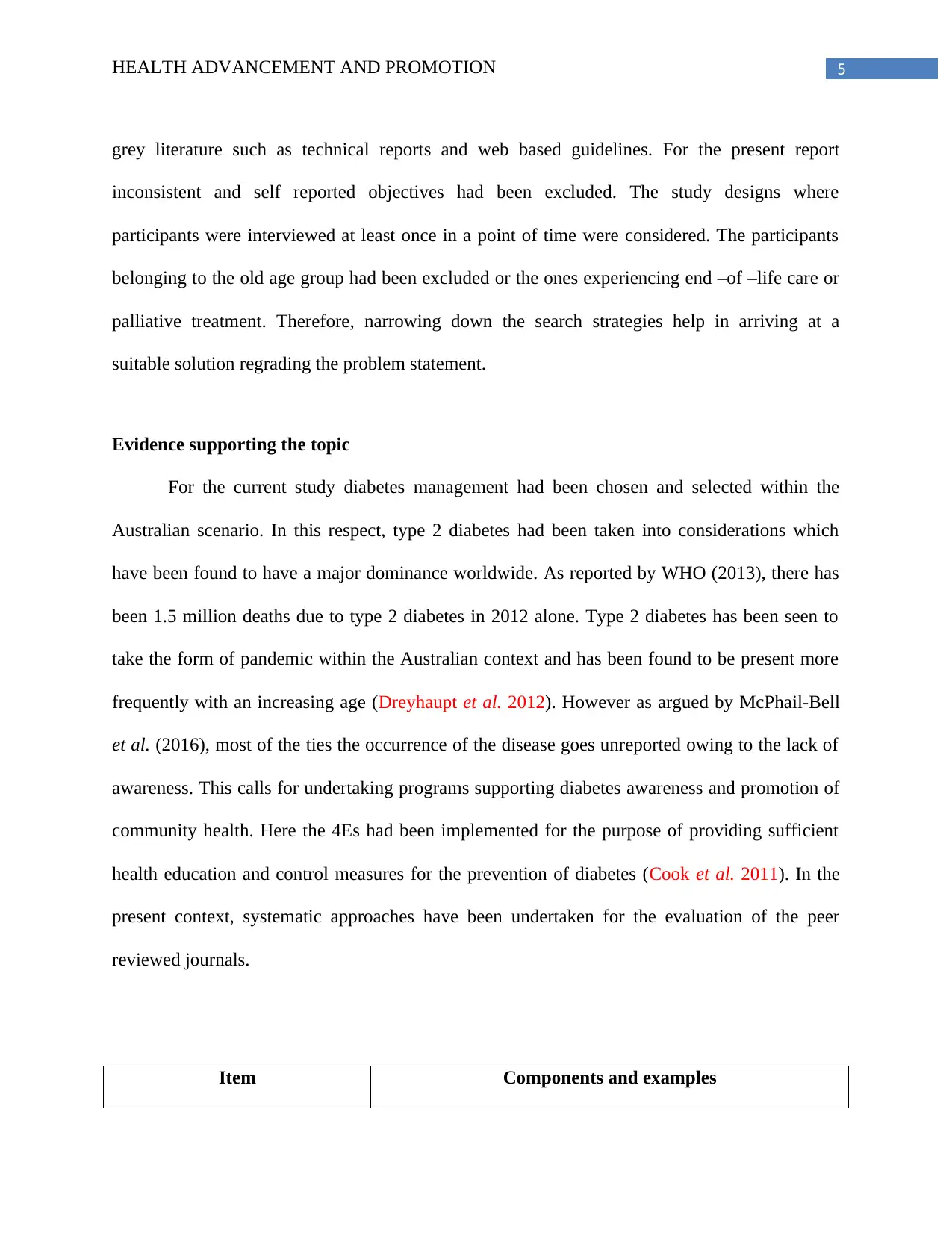
5HEALTH ADVANCEMENT AND PROMOTION
grey literature such as technical reports and web based guidelines. For the present report
inconsistent and self reported objectives had been excluded. The study designs where
participants were interviewed at least once in a point of time were considered. The participants
belonging to the old age group had been excluded or the ones experiencing end –of –life care or
palliative treatment. Therefore, narrowing down the search strategies help in arriving at a
suitable solution regrading the problem statement.
Evidence supporting the topic
For the current study diabetes management had been chosen and selected within the
Australian scenario. In this respect, type 2 diabetes had been taken into considerations which
have been found to have a major dominance worldwide. As reported by WHO (2013), there has
been 1.5 million deaths due to type 2 diabetes in 2012 alone. Type 2 diabetes has been seen to
take the form of pandemic within the Australian context and has been found to be present more
frequently with an increasing age (Dreyhaupt et al. 2012). However as argued by McPhail-Bell
et al. (2016), most of the ties the occurrence of the disease goes unreported owing to the lack of
awareness. This calls for undertaking programs supporting diabetes awareness and promotion of
community health. Here the 4Es had been implemented for the purpose of providing sufficient
health education and control measures for the prevention of diabetes (Cook et al. 2011). In the
present context, systematic approaches have been undertaken for the evaluation of the peer
reviewed journals.
Item Components and examples
grey literature such as technical reports and web based guidelines. For the present report
inconsistent and self reported objectives had been excluded. The study designs where
participants were interviewed at least once in a point of time were considered. The participants
belonging to the old age group had been excluded or the ones experiencing end –of –life care or
palliative treatment. Therefore, narrowing down the search strategies help in arriving at a
suitable solution regrading the problem statement.
Evidence supporting the topic
For the current study diabetes management had been chosen and selected within the
Australian scenario. In this respect, type 2 diabetes had been taken into considerations which
have been found to have a major dominance worldwide. As reported by WHO (2013), there has
been 1.5 million deaths due to type 2 diabetes in 2012 alone. Type 2 diabetes has been seen to
take the form of pandemic within the Australian context and has been found to be present more
frequently with an increasing age (Dreyhaupt et al. 2012). However as argued by McPhail-Bell
et al. (2016), most of the ties the occurrence of the disease goes unreported owing to the lack of
awareness. This calls for undertaking programs supporting diabetes awareness and promotion of
community health. Here the 4Es had been implemented for the purpose of providing sufficient
health education and control measures for the prevention of diabetes (Cook et al. 2011). In the
present context, systematic approaches have been undertaken for the evaluation of the peer
reviewed journals.
Item Components and examples
⊘ This is a preview!⊘
Do you want full access?
Subscribe today to unlock all pages.

Trusted by 1+ million students worldwide
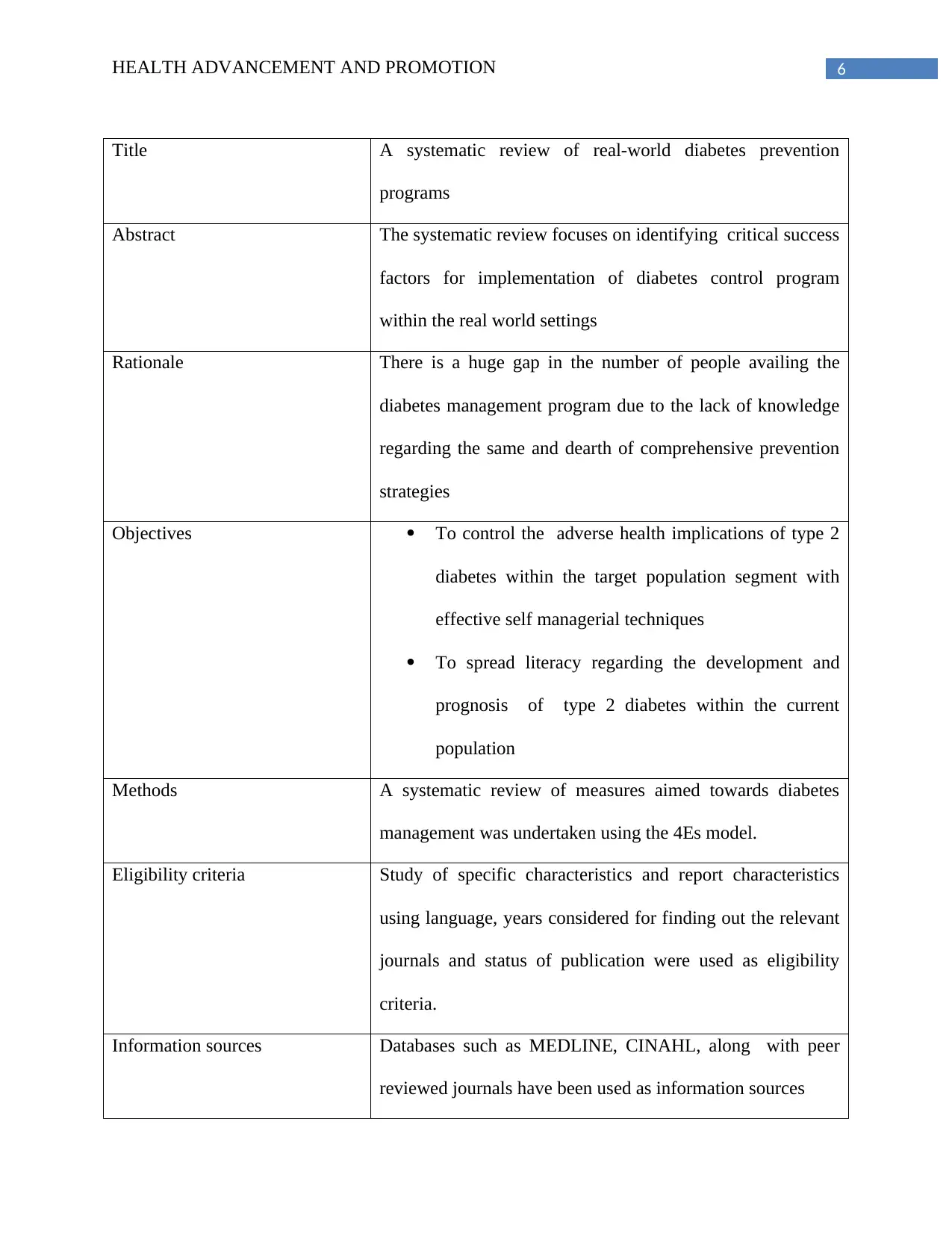
6HEALTH ADVANCEMENT AND PROMOTION
Title A systematic review of real-world diabetes prevention
programs
Abstract The systematic review focuses on identifying critical success
factors for implementation of diabetes control program
within the real world settings
Rationale There is a huge gap in the number of people availing the
diabetes management program due to the lack of knowledge
regarding the same and dearth of comprehensive prevention
strategies
Objectives To control the adverse health implications of type 2
diabetes within the target population segment with
effective self managerial techniques
To spread literacy regarding the development and
prognosis of type 2 diabetes within the current
population
Methods A systematic review of measures aimed towards diabetes
management was undertaken using the 4Es model.
Eligibility criteria Study of specific characteristics and report characteristics
using language, years considered for finding out the relevant
journals and status of publication were used as eligibility
criteria.
Information sources Databases such as MEDLINE, CINAHL, along with peer
reviewed journals have been used as information sources
Title A systematic review of real-world diabetes prevention
programs
Abstract The systematic review focuses on identifying critical success
factors for implementation of diabetes control program
within the real world settings
Rationale There is a huge gap in the number of people availing the
diabetes management program due to the lack of knowledge
regarding the same and dearth of comprehensive prevention
strategies
Objectives To control the adverse health implications of type 2
diabetes within the target population segment with
effective self managerial techniques
To spread literacy regarding the development and
prognosis of type 2 diabetes within the current
population
Methods A systematic review of measures aimed towards diabetes
management was undertaken using the 4Es model.
Eligibility criteria Study of specific characteristics and report characteristics
using language, years considered for finding out the relevant
journals and status of publication were used as eligibility
criteria.
Information sources Databases such as MEDLINE, CINAHL, along with peer
reviewed journals have been used as information sources
Paraphrase This Document
Need a fresh take? Get an instant paraphrase of this document with our AI Paraphraser
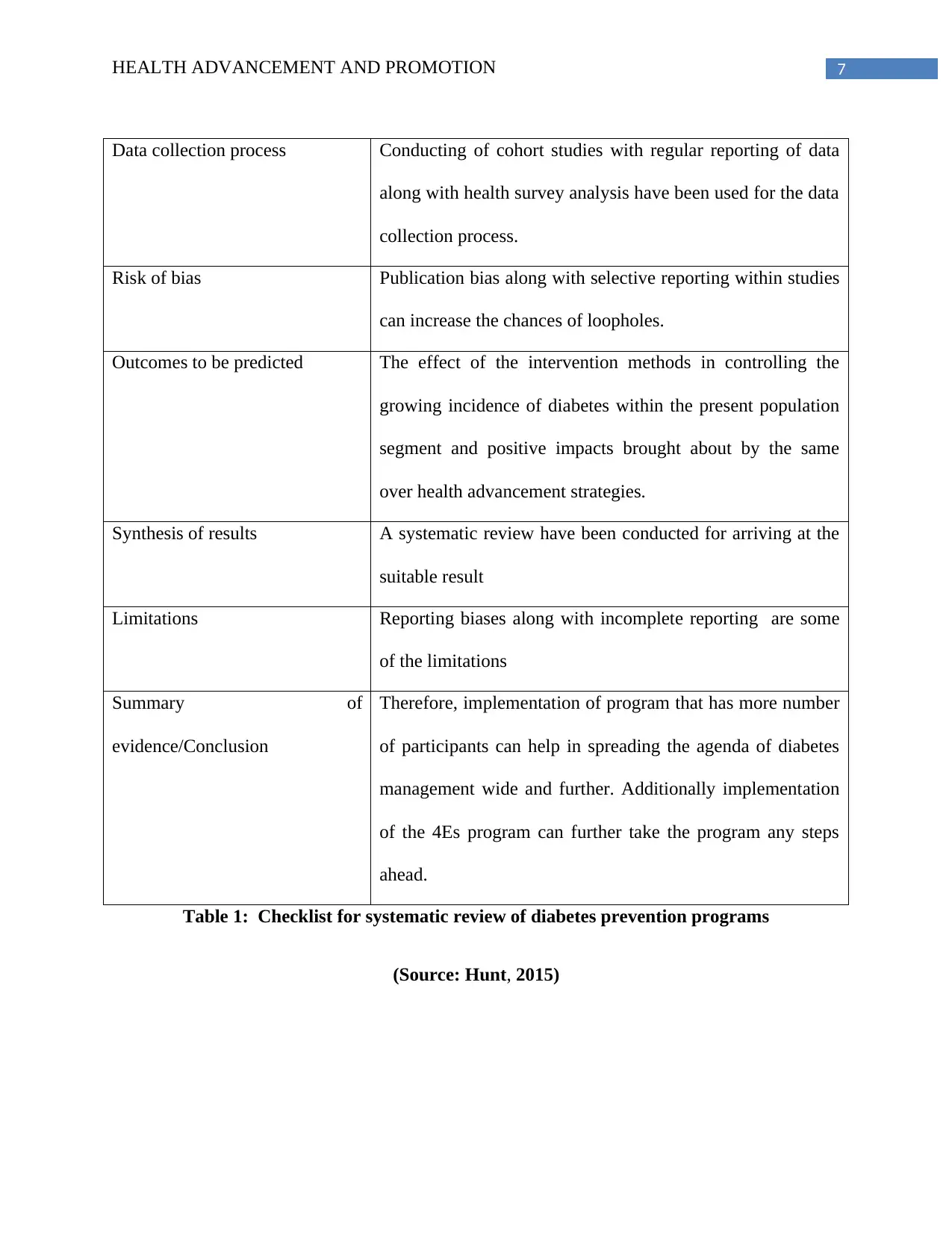
7HEALTH ADVANCEMENT AND PROMOTION
Data collection process Conducting of cohort studies with regular reporting of data
along with health survey analysis have been used for the data
collection process.
Risk of bias Publication bias along with selective reporting within studies
can increase the chances of loopholes.
Outcomes to be predicted The effect of the intervention methods in controlling the
growing incidence of diabetes within the present population
segment and positive impacts brought about by the same
over health advancement strategies.
Synthesis of results A systematic review have been conducted for arriving at the
suitable result
Limitations Reporting biases along with incomplete reporting are some
of the limitations
Summary of
evidence/Conclusion
Therefore, implementation of program that has more number
of participants can help in spreading the agenda of diabetes
management wide and further. Additionally implementation
of the 4Es program can further take the program any steps
ahead.
Table 1: Checklist for systematic review of diabetes prevention programs
(Source: Hunt, 2015)
Data collection process Conducting of cohort studies with regular reporting of data
along with health survey analysis have been used for the data
collection process.
Risk of bias Publication bias along with selective reporting within studies
can increase the chances of loopholes.
Outcomes to be predicted The effect of the intervention methods in controlling the
growing incidence of diabetes within the present population
segment and positive impacts brought about by the same
over health advancement strategies.
Synthesis of results A systematic review have been conducted for arriving at the
suitable result
Limitations Reporting biases along with incomplete reporting are some
of the limitations
Summary of
evidence/Conclusion
Therefore, implementation of program that has more number
of participants can help in spreading the agenda of diabetes
management wide and further. Additionally implementation
of the 4Es program can further take the program any steps
ahead.
Table 1: Checklist for systematic review of diabetes prevention programs
(Source: Hunt, 2015)
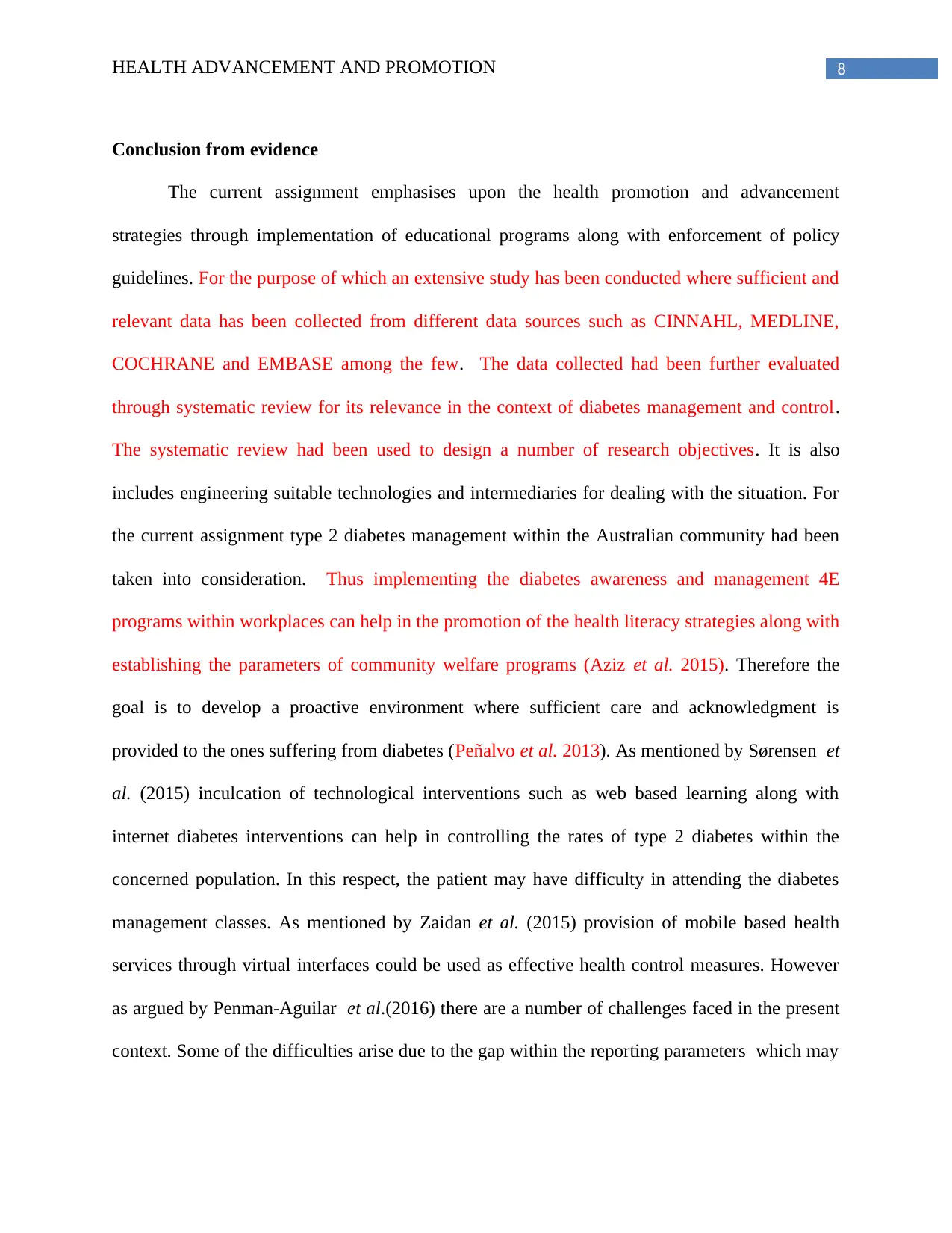
8HEALTH ADVANCEMENT AND PROMOTION
Conclusion from evidence
The current assignment emphasises upon the health promotion and advancement
strategies through implementation of educational programs along with enforcement of policy
guidelines. For the purpose of which an extensive study has been conducted where sufficient and
relevant data has been collected from different data sources such as CINNAHL, MEDLINE,
COCHRANE and EMBASE among the few. The data collected had been further evaluated
through systematic review for its relevance in the context of diabetes management and control.
The systematic review had been used to design a number of research objectives. It is also
includes engineering suitable technologies and intermediaries for dealing with the situation. For
the current assignment type 2 diabetes management within the Australian community had been
taken into consideration. Thus implementing the diabetes awareness and management 4E
programs within workplaces can help in the promotion of the health literacy strategies along with
establishing the parameters of community welfare programs (Aziz et al. 2015). Therefore the
goal is to develop a proactive environment where sufficient care and acknowledgment is
provided to the ones suffering from diabetes (Peñalvo et al. 2013). As mentioned by Sørensen et
al. (2015) inculcation of technological interventions such as web based learning along with
internet diabetes interventions can help in controlling the rates of type 2 diabetes within the
concerned population. In this respect, the patient may have difficulty in attending the diabetes
management classes. As mentioned by Zaidan et al. (2015) provision of mobile based health
services through virtual interfaces could be used as effective health control measures. However
as argued by Penman-Aguilar et al.(2016) there are a number of challenges faced in the present
context. Some of the difficulties arise due to the gap within the reporting parameters which may
Conclusion from evidence
The current assignment emphasises upon the health promotion and advancement
strategies through implementation of educational programs along with enforcement of policy
guidelines. For the purpose of which an extensive study has been conducted where sufficient and
relevant data has been collected from different data sources such as CINNAHL, MEDLINE,
COCHRANE and EMBASE among the few. The data collected had been further evaluated
through systematic review for its relevance in the context of diabetes management and control.
The systematic review had been used to design a number of research objectives. It is also
includes engineering suitable technologies and intermediaries for dealing with the situation. For
the current assignment type 2 diabetes management within the Australian community had been
taken into consideration. Thus implementing the diabetes awareness and management 4E
programs within workplaces can help in the promotion of the health literacy strategies along with
establishing the parameters of community welfare programs (Aziz et al. 2015). Therefore the
goal is to develop a proactive environment where sufficient care and acknowledgment is
provided to the ones suffering from diabetes (Peñalvo et al. 2013). As mentioned by Sørensen et
al. (2015) inculcation of technological interventions such as web based learning along with
internet diabetes interventions can help in controlling the rates of type 2 diabetes within the
concerned population. In this respect, the patient may have difficulty in attending the diabetes
management classes. As mentioned by Zaidan et al. (2015) provision of mobile based health
services through virtual interfaces could be used as effective health control measures. However
as argued by Penman-Aguilar et al.(2016) there are a number of challenges faced in the present
context. Some of the difficulties arise due to the gap within the reporting parameters which may
⊘ This is a preview!⊘
Do you want full access?
Subscribe today to unlock all pages.

Trusted by 1+ million students worldwide
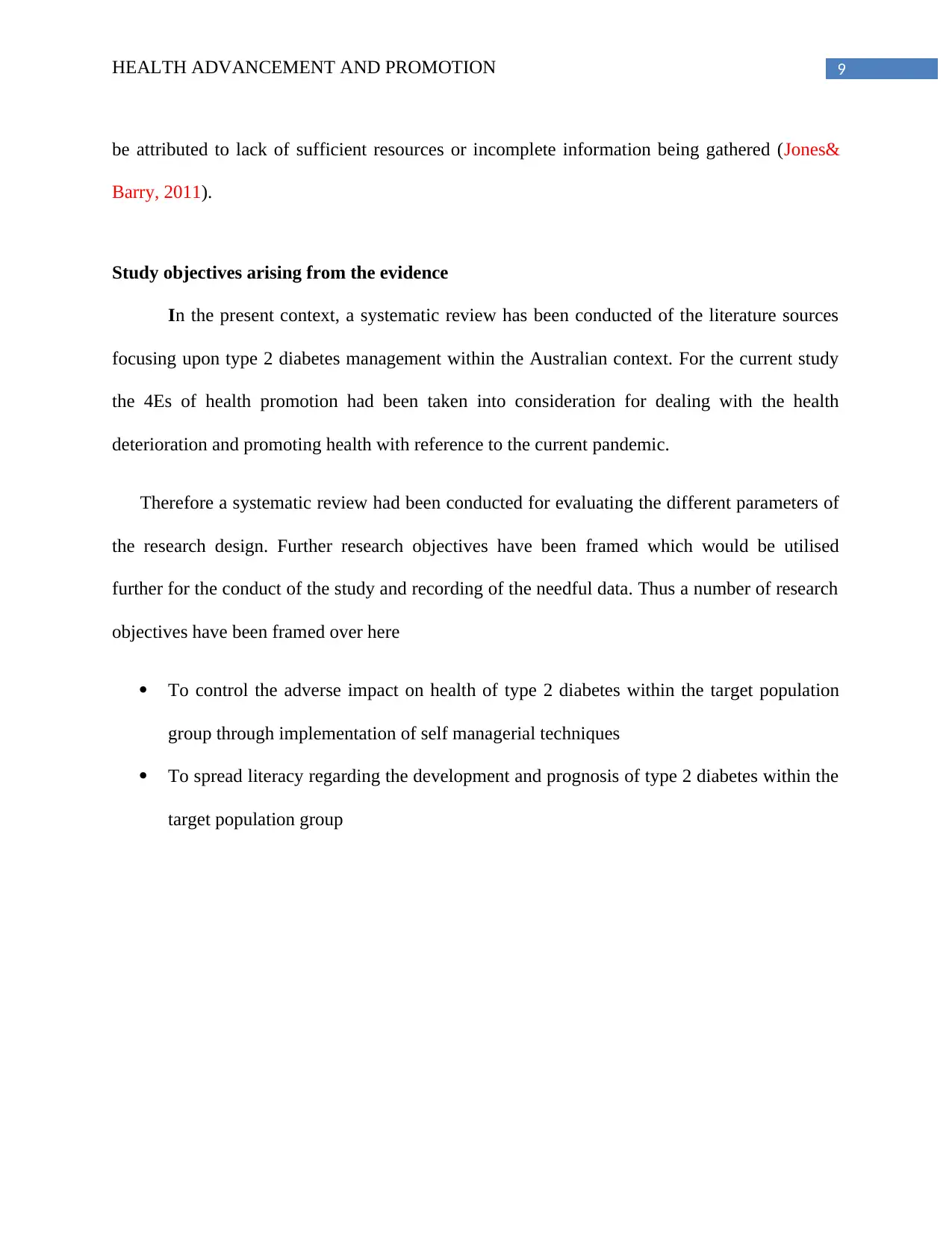
9HEALTH ADVANCEMENT AND PROMOTION
be attributed to lack of sufficient resources or incomplete information being gathered (Jones&
Barry, 2011).
Study objectives arising from the evidence
In the present context, a systematic review has been conducted of the literature sources
focusing upon type 2 diabetes management within the Australian context. For the current study
the 4Es of health promotion had been taken into consideration for dealing with the health
deterioration and promoting health with reference to the current pandemic.
Therefore a systematic review had been conducted for evaluating the different parameters of
the research design. Further research objectives have been framed which would be utilised
further for the conduct of the study and recording of the needful data. Thus a number of research
objectives have been framed over here
To control the adverse impact on health of type 2 diabetes within the target population
group through implementation of self managerial techniques
To spread literacy regarding the development and prognosis of type 2 diabetes within the
target population group
be attributed to lack of sufficient resources or incomplete information being gathered (Jones&
Barry, 2011).
Study objectives arising from the evidence
In the present context, a systematic review has been conducted of the literature sources
focusing upon type 2 diabetes management within the Australian context. For the current study
the 4Es of health promotion had been taken into consideration for dealing with the health
deterioration and promoting health with reference to the current pandemic.
Therefore a systematic review had been conducted for evaluating the different parameters of
the research design. Further research objectives have been framed which would be utilised
further for the conduct of the study and recording of the needful data. Thus a number of research
objectives have been framed over here
To control the adverse impact on health of type 2 diabetes within the target population
group through implementation of self managerial techniques
To spread literacy regarding the development and prognosis of type 2 diabetes within the
target population group
Paraphrase This Document
Need a fresh take? Get an instant paraphrase of this document with our AI Paraphraser
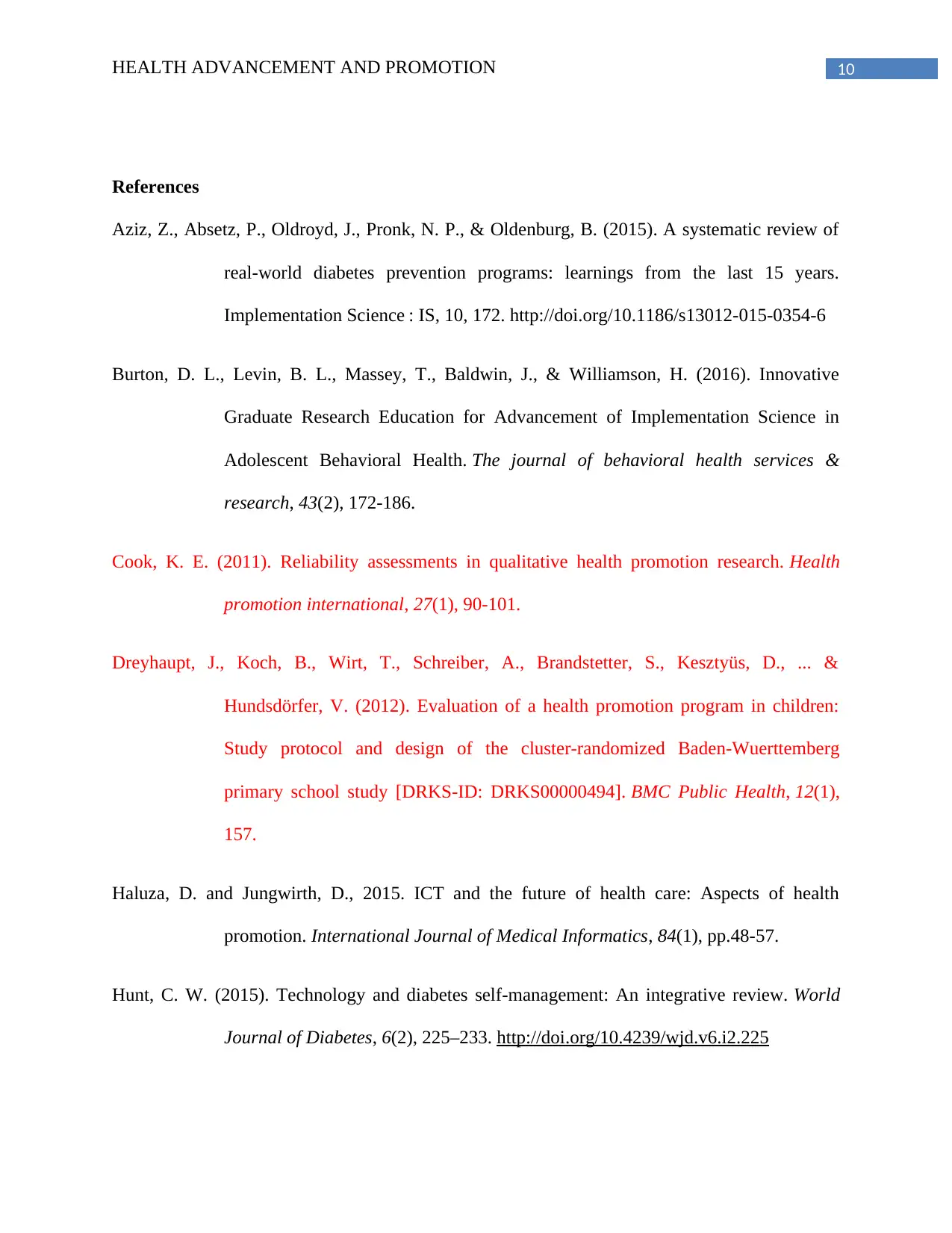
10HEALTH ADVANCEMENT AND PROMOTION
References
Aziz, Z., Absetz, P., Oldroyd, J., Pronk, N. P., & Oldenburg, B. (2015). A systematic review of
real-world diabetes prevention programs: learnings from the last 15 years.
Implementation Science : IS, 10, 172. http://doi.org/10.1186/s13012-015-0354-6
Burton, D. L., Levin, B. L., Massey, T., Baldwin, J., & Williamson, H. (2016). Innovative
Graduate Research Education for Advancement of Implementation Science in
Adolescent Behavioral Health. The journal of behavioral health services &
research, 43(2), 172-186.
Cook, K. E. (2011). Reliability assessments in qualitative health promotion research. Health
promotion international, 27(1), 90-101.
Dreyhaupt, J., Koch, B., Wirt, T., Schreiber, A., Brandstetter, S., Kesztyüs, D., ... &
Hundsdörfer, V. (2012). Evaluation of a health promotion program in children:
Study protocol and design of the cluster-randomized Baden-Wuerttemberg
primary school study [DRKS-ID: DRKS00000494]. BMC Public Health, 12(1),
157.
Haluza, D. and Jungwirth, D., 2015. ICT and the future of health care: Aspects of health
promotion. International Journal of Medical Informatics, 84(1), pp.48-57.
Hunt, C. W. (2015). Technology and diabetes self-management: An integrative review. World
Journal of Diabetes, 6(2), 225–233. http://doi.org/10.4239/wjd.v6.i2.225
References
Aziz, Z., Absetz, P., Oldroyd, J., Pronk, N. P., & Oldenburg, B. (2015). A systematic review of
real-world diabetes prevention programs: learnings from the last 15 years.
Implementation Science : IS, 10, 172. http://doi.org/10.1186/s13012-015-0354-6
Burton, D. L., Levin, B. L., Massey, T., Baldwin, J., & Williamson, H. (2016). Innovative
Graduate Research Education for Advancement of Implementation Science in
Adolescent Behavioral Health. The journal of behavioral health services &
research, 43(2), 172-186.
Cook, K. E. (2011). Reliability assessments in qualitative health promotion research. Health
promotion international, 27(1), 90-101.
Dreyhaupt, J., Koch, B., Wirt, T., Schreiber, A., Brandstetter, S., Kesztyüs, D., ... &
Hundsdörfer, V. (2012). Evaluation of a health promotion program in children:
Study protocol and design of the cluster-randomized Baden-Wuerttemberg
primary school study [DRKS-ID: DRKS00000494]. BMC Public Health, 12(1),
157.
Haluza, D. and Jungwirth, D., 2015. ICT and the future of health care: Aspects of health
promotion. International Journal of Medical Informatics, 84(1), pp.48-57.
Hunt, C. W. (2015). Technology and diabetes self-management: An integrative review. World
Journal of Diabetes, 6(2), 225–233. http://doi.org/10.4239/wjd.v6.i2.225
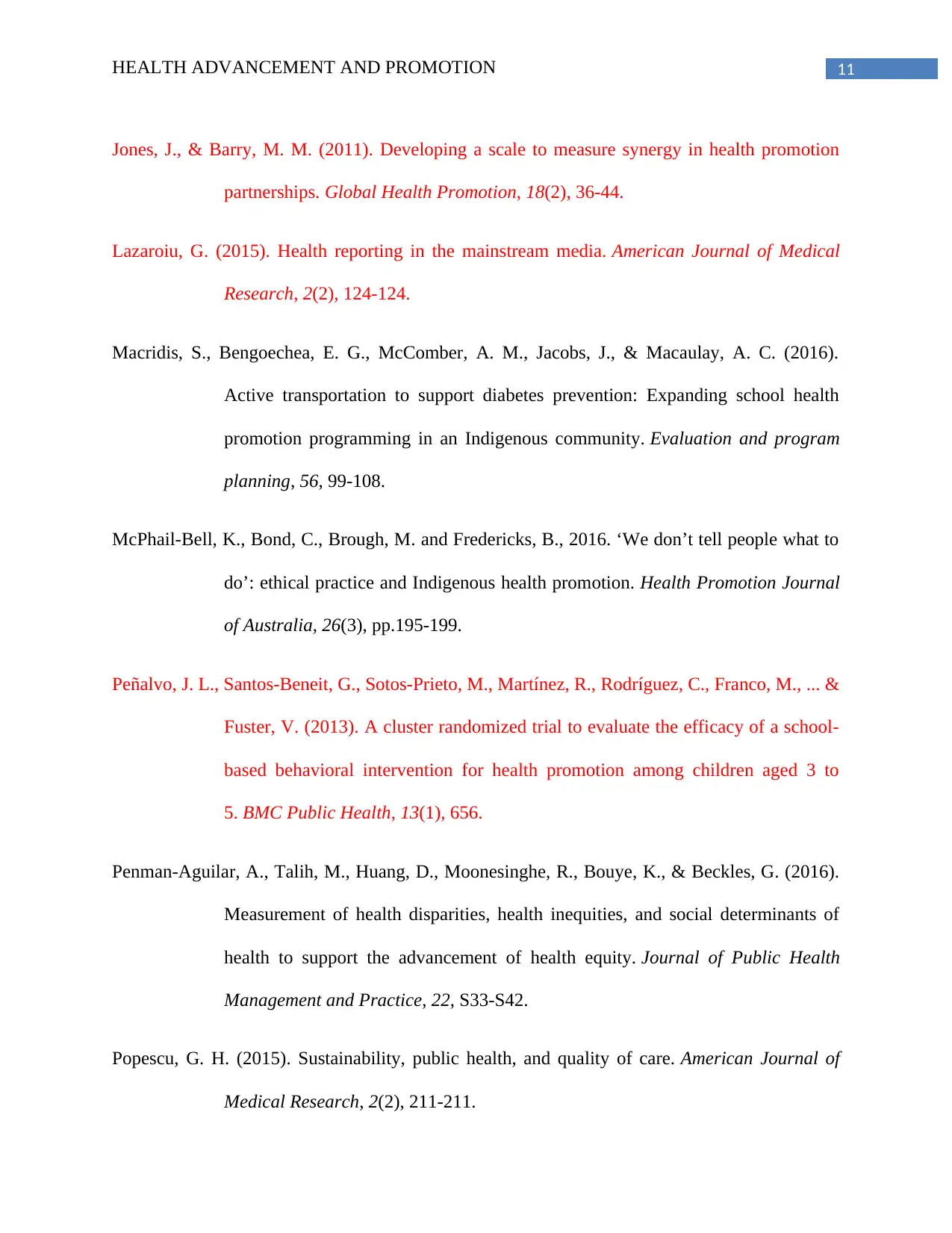
11HEALTH ADVANCEMENT AND PROMOTION
Jones, J., & Barry, M. M. (2011). Developing a scale to measure synergy in health promotion
partnerships. Global Health Promotion, 18(2), 36-44.
Lazaroiu, G. (2015). Health reporting in the mainstream media. American Journal of Medical
Research, 2(2), 124-124.
Macridis, S., Bengoechea, E. G., McComber, A. M., Jacobs, J., & Macaulay, A. C. (2016).
Active transportation to support diabetes prevention: Expanding school health
promotion programming in an Indigenous community. Evaluation and program
planning, 56, 99-108.
McPhail-Bell, K., Bond, C., Brough, M. and Fredericks, B., 2016. ‘We don’t tell people what to
do’: ethical practice and Indigenous health promotion. Health Promotion Journal
of Australia, 26(3), pp.195-199.
Peñalvo, J. L., Santos-Beneit, G., Sotos-Prieto, M., Martínez, R., Rodríguez, C., Franco, M., ... &
Fuster, V. (2013). A cluster randomized trial to evaluate the efficacy of a school-
based behavioral intervention for health promotion among children aged 3 to
5. BMC Public Health, 13(1), 656.
Penman-Aguilar, A., Talih, M., Huang, D., Moonesinghe, R., Bouye, K., & Beckles, G. (2016).
Measurement of health disparities, health inequities, and social determinants of
health to support the advancement of health equity. Journal of Public Health
Management and Practice, 22, S33-S42.
Popescu, G. H. (2015). Sustainability, public health, and quality of care. American Journal of
Medical Research, 2(2), 211-211.
Jones, J., & Barry, M. M. (2011). Developing a scale to measure synergy in health promotion
partnerships. Global Health Promotion, 18(2), 36-44.
Lazaroiu, G. (2015). Health reporting in the mainstream media. American Journal of Medical
Research, 2(2), 124-124.
Macridis, S., Bengoechea, E. G., McComber, A. M., Jacobs, J., & Macaulay, A. C. (2016).
Active transportation to support diabetes prevention: Expanding school health
promotion programming in an Indigenous community. Evaluation and program
planning, 56, 99-108.
McPhail-Bell, K., Bond, C., Brough, M. and Fredericks, B., 2016. ‘We don’t tell people what to
do’: ethical practice and Indigenous health promotion. Health Promotion Journal
of Australia, 26(3), pp.195-199.
Peñalvo, J. L., Santos-Beneit, G., Sotos-Prieto, M., Martínez, R., Rodríguez, C., Franco, M., ... &
Fuster, V. (2013). A cluster randomized trial to evaluate the efficacy of a school-
based behavioral intervention for health promotion among children aged 3 to
5. BMC Public Health, 13(1), 656.
Penman-Aguilar, A., Talih, M., Huang, D., Moonesinghe, R., Bouye, K., & Beckles, G. (2016).
Measurement of health disparities, health inequities, and social determinants of
health to support the advancement of health equity. Journal of Public Health
Management and Practice, 22, S33-S42.
Popescu, G. H. (2015). Sustainability, public health, and quality of care. American Journal of
Medical Research, 2(2), 211-211.
⊘ This is a preview!⊘
Do you want full access?
Subscribe today to unlock all pages.

Trusted by 1+ million students worldwide
1 out of 13
Related Documents
Your All-in-One AI-Powered Toolkit for Academic Success.
+13062052269
info@desklib.com
Available 24*7 on WhatsApp / Email
![[object Object]](/_next/static/media/star-bottom.7253800d.svg)
Unlock your academic potential
Copyright © 2020–2025 A2Z Services. All Rights Reserved. Developed and managed by ZUCOL.





